2 Scoping
2.1 S etting Broad Development and Management Objectives
Broad Development Objectives
The broad development and management objectives for Aquaculture Parks are stipulated in the Aquaculture Park Investment Policy (MAAIF, 2012). According to this policy, Aquaculture Parks shall be avenues through which commercial producers are clustered within a specified area out of which viable levels of production that attract desired market segments and stimulate the development of ‘Aquaculture Park value chains’ can be achieved. This concept is illustrated in Figure 1.
The specific development objectives for Aquaculture Parks in Uganda are (Mugabira et al., 2013):
1. To increase the value of aquaculture production from the present average of US $180 million annually to at least US $600 million.
2. To increase the volume of aquaculture production from 90,000 tonnes to 300,000 tonnes annually.
3. To identify, assess and support the development of infrastructure and utility services for potential sites on land and water, each promoting at least 5,000 tonnes annually.
4. To identify and attract potential investors for aquaculture production and associated inputs.
5. To organise rural smallholder fish farmers into producer groups that can compete for the operation and management of aquaculture parks.
6. To promote sustainable management and operational systems through associations of Aquaculture Parks.
Figure 1. Aquaculture Parks value chain process map.
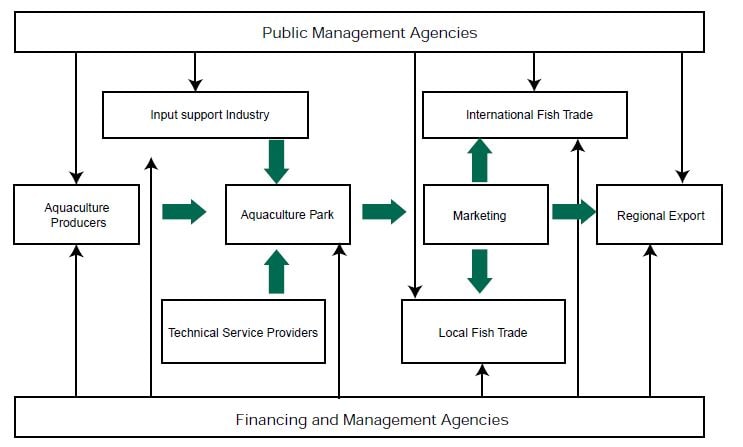
Source: MAAIF (2012).
7. To promote coordination among the respective public and private agencies in the development and management of Aquaculture Parks.
8. To build capacity in the private sector and at central and local government levels.
9. To support, regulate and guide the development of Aquaculture Parks.
10. To develop and adopt environmentally friendly aquaculture technologies and practices.
The development of aquaculture parks in Uganda should consider environmental, social, economic and governance aspects. The use of appropriate aquaculture production systems that match the available resources is advocated for. In addition, so is the participation of both the public and private sector in a positive manner whereby both parties contribute equitably depending on their comparative advantage.
Management Objectives
It is proposed that the Aquaculture Parks be run as independent self-sustaining Public-Private-Partnership enterprises that can within the legislated framework sustainably produce and market up to 5,000 tonnes of fish per annum (MAAIF, 2012, Mugabira et al., 2013).
This PPP may be in association with a large-scale private sector partner that directly invests in the park or pays a fee to the government to produce within the park (the nucleus estate model). The APs are to be managed based upon sound scientific principles. Thus research and training institutions shall play a key role in ensuring appropriate technology is developed and effectively adopted by appropriately trained personnel, farmers inclusive.
Figure 2 illustrates the Aquaculture Parks conceptual business management model and the roles of the private and public sectors in securing capital and in
Figure 2. Proposed Aquaculture Park company structure (MAAIF/EU, 2013).
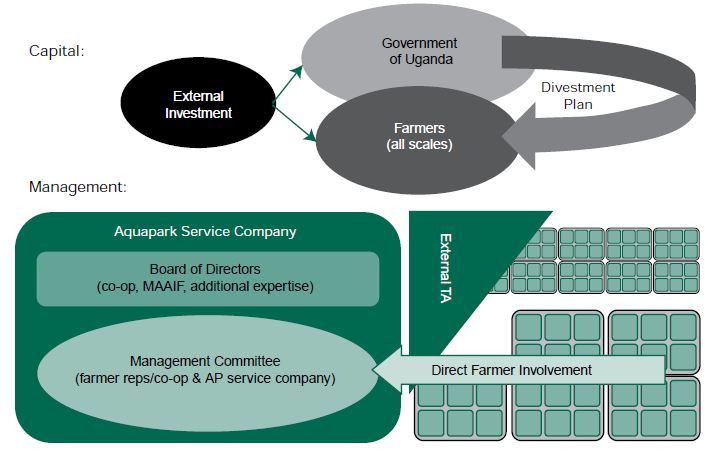
Aquaculture Parks management. It is proposed that the Aquaculture Parks be managed by an independent service company overseen by a Board of Directors.
Farmers would in this case participate in the management through representatives or their cooperative.
Initially the Government finances would be used to establish the Aquaculture Parks. A share offer (open to prospective farmers initially) would help recoup a proportion of the capital costs and provide working capital for the farm (purchase of equipment, feed, labour, etc., ahead of revenue from production). The Aquaculture Parks would then become self-supporting.
2.2 Legal, Regulatory and Institutional Frameworks
Aquaculture Park policy activities are coordinated by the National Planning Authority of the Ministry of Finance, Planning and Economic Development.
However, the Fisheries Resources Department under the Ministry of Agriculture Animal Industry and Fisheries plays the leading role in implementing these policies with the help of Local Government. Other key lead agencies playing a key role in Aquaculture Parks development are the Directorate of Water Resources in the Ministry of Water and Environment, Ministry of Lands and Urban Development and Ministry of Tourism, Trade and Industry. The key statutory bodies involved are the National Environment Management Authority, Uganda Investment Authority and Uganda Wildlife Authority.
The principle policies that guide the development and management of Aquaculture Parks are the National Fisheries Policy and the National Aquaculture Parks Investment Policy. A summary of these and other key policies is described in Table 1.
The primary regulations governing aquaculture are summarized in Table 2.
Table 1. Policies directing Aquaculture Park development in Uganda.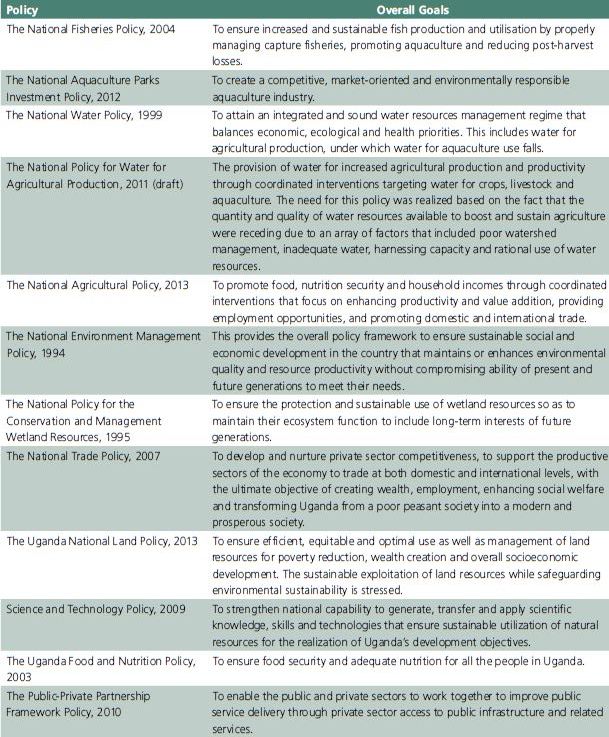
Table 2. Legal and regulatory framework.
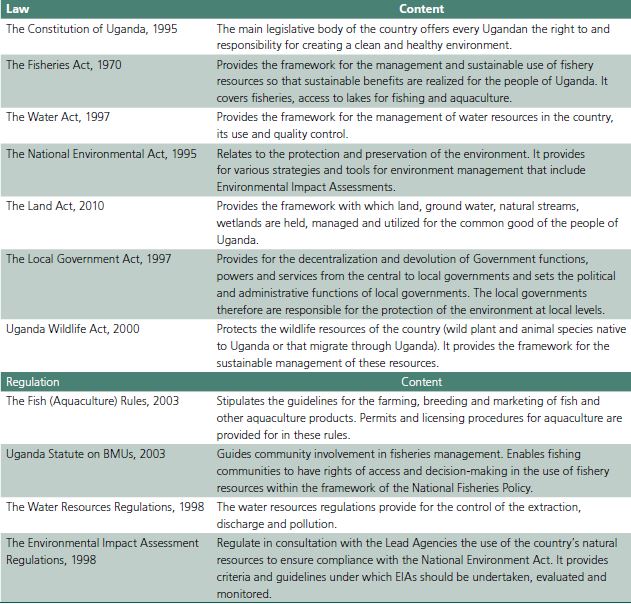
2.3 Consultation with Stakeholders
The development and adoption of the Aquaculture Park Concept has involved an almost ten-year participatory consultative process (Table 3). Stakeholder consultations between the public and private sector were done through all stages of concept development.
These included public awareness programs.
Within the public sector, the different key agencies notably fish/agricultural production, fish trade, water development and management, environmental management, local governance, community development as well as research and training were consulted.
Within the private sector, producers, traders, fishermen, farmers, manufacturers, input suppliers, extension service providers and local communities were consulted. Development agencies were also consulted. Studies were done to advise the process (USAID, 2009, EU/MAAIF, 2013, EU/MAAIF, 2011).
Table 3. Documents in which zoning for commercial Aquaculture Development and/or Aquaculture Parks have been discussed.
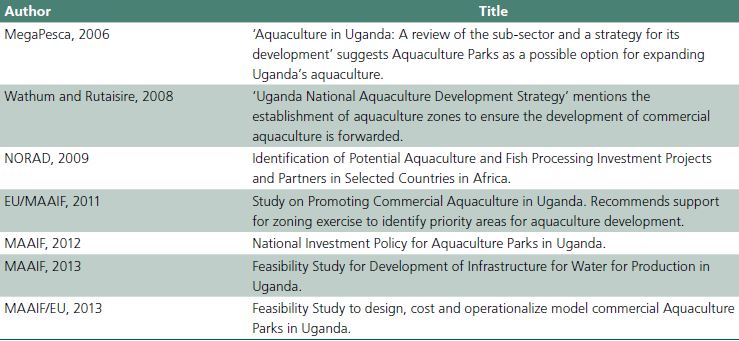
As a result of this process, the Aquaculture Working Group that comprises representative stakeholders from both the private and public sectors was set up.
The role of this working group is to continuously advice and give feedback on policy and the status of commercial aquaculture development in the country (MAAIF, 2012).
The outcome of this process has been the Concept of Aquaculture Parks. The feasibility of undertaking this approach has been found to be potentially among the most viable options for promoting sustainable aquaculture development in the country, in a manner that accommodates smallholder producers and stimulates rural development. None of the above studies undertook spatial analysis.